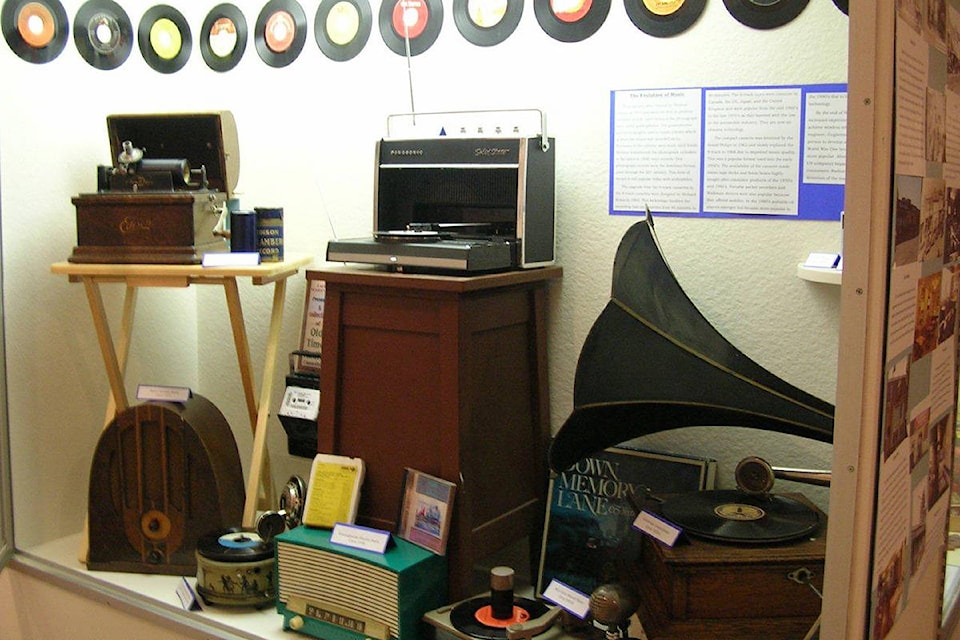Among my countless memories of growing up in and around Ponoka was of going to local music concerts or dances, which likely started way back as a youngster when our family spent many hours of relaxing in our tiny little living room quietly listening to our totally antique R.C.A. Victor record player.
Through our father’s work with the Provincial Mental Hospital Recreation Department he always had access to thousands of those various sizes of flat black wax records with the hole in the middle, which included everything from jazz, to opera, to early rock and roll, to the big bands, bluegrass, western, and dance, as well as some of the popular artists of the era, and so much more.
The ladies at the Fort Ostell Museum have put together another classic display to delight visitors of young and old, and this one is dedicated to the Record and Cylinder Players, Radios, Microphones, C.D. and cassette machines, as well as some of the favourite old records and artists that those of us who grew up in the roaring 1950s and ’60s may still fondly remember?
Marching through those colourful early years that featured all the glitz from the mellow to the madness of music for all ages, this amazing new display honours the amazing machines that brought those magic sounds into our homes and hearts. Some of these models, most of which are now very rare or gone forever include: Edison’s first Cylinder player from 1898 to 1905, a Philco wooden radio (1915), a Nifty Nirona German record player (1930), a 1938 Westinghouse Electric Radio, a 1942 Bullet Microphone, the classic and very popular RCA Victor Record player of the 1950s (with the big horn speaker), the Real Triple Play Cassette/Radio and Panasonic Solid State Auto set that roared onto the entertainment scene in the 1970s, and on and on.
I really had to chuckle and shake out some fond memories when I browsed through a wall full of red hot 45 and 78 records that included: Something’s Burning by Kenny Rogers and the First Edition, Jungle Dream, Stay Away from my Baby by Lynda Layne, Devil Woman by Ringo Starr, a Declaration of Love by the Supremes, the magic of legendary Nat King Cole, and many others that will make many of us yearn to bring back those discs and croon our favourite old tunes once again.
The great evolution of music
Likely the very first exciting production of recorded sound would occur in 1877 when the gentle genius Thomas Edison created the phonograph.
Later forms of this invention were called gramophones, and both would feature round cylinders on which the sound was recorded onto. Along the way many revisions were made to the cylinders, but then in 1890 the next milestone occurred when Emile Berliner transitioned the circular cylinders into the flat discs known as vinyl records. These spinning records on many fancier new types of phonographs became extremely popular throughout the 19th century, and some are still being used today with audiophiles.
The amazing upgrade from the original 4-track cassettes to the 8-track models were designed and introduced to the public by Richard Kraus in 1963, and this speedy and modern technology would double the recording time on cassettes from 40 to eight minutes. These 8-track tapes, which are now obsolete, were very popular in Canada, the United States, Japan, and the United Kingdom through the 1960s and ’70s as they boomed along with avid use in the fast growing automobile industry. The compact cassette was invented by the Philips brand company in 1962 and would slowly replace the eight track models due to their improved music quality and sound. This rapid availability of the cassette made stereo tape decks and boom boxes highly sought after products in the roaring ’70s and beyond. Then along came the nifty portable pocket recorders and Walkman devices, which were extremely popular because they offered easy mobility, which was improved even more in the 1990s with the addition of the anti-skip technology.
By the end of the 19th century there were increased experiments using the radio waves to achieve fantastic new wireless telegraphy. An Italian electrical engineer, Guglielmo Marconi was the first person to develop a working model, and prior to World War one broadcasting radios would become very popular. Following the war years Westinghouse began mass producing radio sets for consumers, and then in 1947 radios became portable with the invention of the transistor. So many us as youngsters will never forget when our dads helped us put together our first really neat crystal radio set, where we spent countless hours listening to music and the news from the rest of the world.
Fast forward to the 20th century we are now blessed with a vast array of fast and fancy mechanical musical technologies and devices that allow music lovers of all ages to up load and download many thousands of their songs on a 24-7 basis no matter where-ever they may be hanging out. Yes, the grand evolution of music has certainly come a long way over a dozen or so decades, but it will be a real treat to drop into the Fort Ostell Museum and see a little history of where it all started to hit the air-waves of the world.
